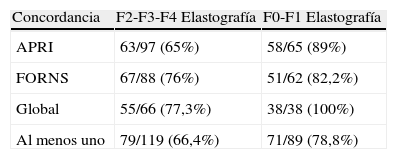Existen métodos diagnósticos no invasivos de fibrosis hepática que se basan en determinaciones bioquímicas (como APRI o Forns) o en elastografía de transición. Este estudio se propone comparar la concordancia entre ellos en pacientes coinfectados por los virus de inmunodeficiencia humana y el de la hepatitis C.
Pacientes y métodosSe realizó elastografía, APRI y Forns a 331 pacientes para valorar la concordancia entre grados avanzados y bajos de fibrosis. Se estimaron los grados de concordancia existentes entre ellos mediante el coeficiente kappa.
ResultadosLos pacientes que presentaron grados intermedios de fibrosis estimados por APRI y Forns (51 y 54% respectivamente) no fueron incluidos en el estudio. La concordancia de la elastografía en el grado avanzado frente al índice APRI fue del 65% y del 76% frente al Forns. Cuando la elastografía obtuvo estimaciones de grado bajo de fibrosis la concordancia con APRI fue del 89 y del 82,2% con Forns. La concordancia global fue del 85,5%, y con al menos un índice bioquímico del 72,1%.
ConclusiónEn los pacientes coinfectados por VIH y VHC la utilización de los índices bioquímicos APRI y Forns para estimar el grado de fibrosis hepática no logra clasificar adecuadamente a al menos la mitad de los pacientes. Sin embargo, en los pacientes clasificados como con fibrosis alta ó baja, la concordancia entre las estimaciones obtenidas mediante la elastografía y las derrivadas de los índices de APRI y de Forns es moderada-alta.
There are non-invasive diagnostic methods of liver fibrosis that are based on biochemical measurements (such as APRI or Forns) or on transient elastography. This study aims to compare the consistency between them in patients coinfected by the human immunodeficiency virus and the hepatitis C virus.
Patients and methodsAn elastography, APRI and Forns were performed for 331 patients to evaluate the consistency between the advanced and low grades of fibrosis. The grades of consistency existing between them were calculated with the kappa coefficient.
ResultsThe grades of fibrosis calculated by APRI and by Forns provided intermediate results (51.1% and 54.7%, respectively), and these patients were not enrolled in the study. The consistency of the elastography in the advanced grade versus the APRI index was 65% and 75% for the Forns index.
When the elastography obtained low grade calculations of fibrosis, the consistency with APRI was 80% and 82.2% with Forns Global consistency was 85.5% and with at least one biochemistry index of 72.1%.
ConclusionIn the HIV and HCV coinfected patients, the use of the APRI and Forns biochemistry indexes to calculate grade of liver fibrosis does not successfully classify at least half of the patients. However, in the patients classified as having high or low fibrosis, the consistency between the calculations obtained by elastography and those derived from the APRI and Forns indexes is moderate to high.
Article
Diríjase desde aquí a la web de la >>>FESEMI<<< e inicie sesión mediante el formulario que se encuentra en la barra superior, pulsando sobre el candado.

Una vez autentificado, en la misma web de FESEMI, en el menú superior, elija la opción deseada.

>>>FESEMI<<<







